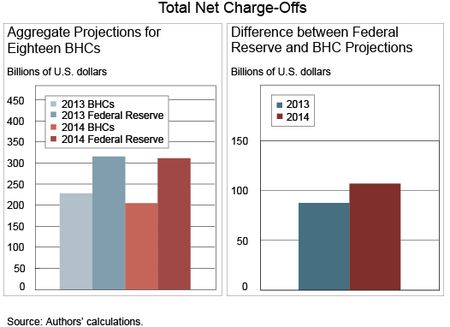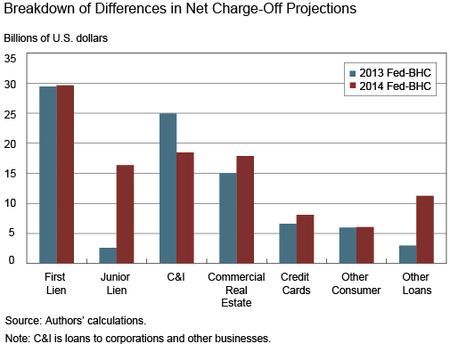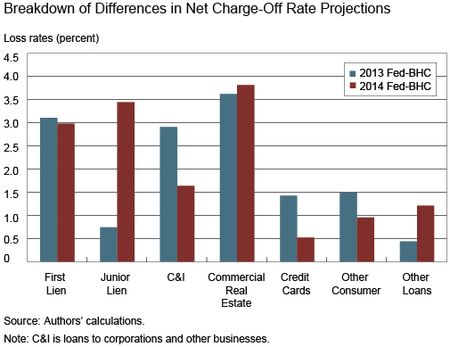Beverly Hirtle, Anna Kovner, and Eric McKay
Stress tests have become an important method of assessing whether financial institutions have enough capital to operate in bad economic conditions. Under the provisions of the Dodd-Frank Act, both the Federal Reserve and large U.S. bank holding companies (BHCs) are required to do annual stress tests and to disclose these results to the public. While the BHCs’ and the Federal Reserve’s projections are made under the same macroeconomic scenario, the results differ, primarily because of differences in the models used to make the projections. In this post, we look at the 2014 stress test projections made by the eighteen largest U.S. BHCs and by the Federal Reserve and compare them to similar numbers from 2013. We are particularly interested in the question of whether the BHCs’ and the Federal Reserve’s results are converging over time, since such convergence could indicate decreased diversity of stress testing approaches in the banking industry.
DFAST and CCAR Stress Testing
The Dodd-Frank Act requires both large BHCs and the Federal Reserve to conduct annual stress tests under macroeconomic scenarios provided by the Federal Reserve. These stress tests are designed to measure the impact of adverse economic and financial market conditions on each BHC’s income and regulatory capital ratios, with the goal of assessing whether the BHC has sufficient capital to withstand these stressed conditions and continue to be a viable financial intermediary. The Dodd-Frank Act stress test (DFAST) results are publicly disclosed by the BHCs and the Federal Reserve. In addition, both BHC-generated and Federal Reserve-generated stress test results are inputs to the Comprehensive Capital Analysis and Review (CCAR), a supervisory exercise conducted by the Federal Reserve to assess large BHCs’ internal capital planning processes and capital adequacy. As described in a previous post, the CCAR is the Federal Reserve’s central approach for assessing capital adequacy at large BHCs.
Because of the role that the Federal Reserve’s stress test projections play in assessing capital adequacy and because these stress test results are publicly disclosed, some have argued that the BHCs have strong incentives to try to mimic the Federal Reserve’s projections. As Schuermann points out, such convergence could be troubling if it indicated that BHCs were diverting resources away from innovating new stress testing techniques; the less the diversity in modeling approaches in the banking industry, the greater the likelihood that a new, emerging source of risk could be overlooked. To explore this concern, we compare the BHC and Federal Reserve stress test projections in 2013 and 2014 to see if the two sets of results are getting closer over time. Such convergence could be an indicator of decreased diversity of stress testing approaches. More benignly, convergence would also be consistent with less uncertainty about possible outcomes for the BHCs under stressed economic conditions, so that even quite different models generate similar results.
Comparing Federal Reserve and BHC Results
The chart on the left below shows projections of net income from BHCs and the Federal Reserve in both 2013 and 2014 under the Federal Reserve’s severely adverse scenario. In the DFAST calculations, net income is calculated as pre-provision net revenue (PPNR)—equal to net interest income plus noninterest income minus noninterest expense—minus losses. Losses include losses on the loan portfolio, losses on securities held for investment, and, for the largest BHCs, mark-to-market losses on the trading portfolio. The net income projections thus capture estimates of the impact of adverse economic conditions not just on the value of assets held by the BHCs, but also on their broader business activities via projections of revenues and expenses in PPNR. The chart shows cumulative net income over the nine quarters of the stress test horizon in the aggregate for the eighteen BHCs that participated in both the 2013 and 2014 DFAST and CCAR programs.
As the chart illustrates, in both 2013 and 2014, aggregate net income for the eighteen BHCs under the severely adverse scenario as projected by the Federal Reserve is much lower than the aggregate of the eighteen individual BHC projections: in 2014, a loss of $188 billion as projected by the Federal Reserve as compared with a loss of about $130 billion as projected by the BHCs. Notably, the difference between Federal Reserve and BHC net income projections is smaller in 2014 than it was in 2013, primarily due to a significantly more negative aggregate net income projection by the BHCs in 2014. This convergence is illustrated in the chart on the right, which shows the difference between the aggregate net income projections by the eighteen BHCs and the projections by the Federal Reserve in 2013 and 2014.
However, this overall convergence masks differences across projections for the main drivers of net income. As shown in the next chart, aggregate BHC projections of PPNR were closer to the Federal Reserve’s projections in 2014 than in 2013. While, in 2013, the Federal Reserve projected lower PPNR than did the BHCs, in 2014, the Federal Reserve’s projections of PPNR actually exceeded those of the eighteen BHCs that participated in both the 2013 and 2014 DFAST.
In contrast, the next chart shows the growing difference between BHC and Federal Reserve projections of loan losses (net charge-offs). This difference increased by $20 billion between 2013 and 2014, primarily reflecting a decrease in projected loan losses by the BHCs.
What loan types are driving the growing difference between BHC and Federal Reserve aggregate net charge-off projections? The results are varied; differences between the BHC and Federal Reserve projections increased for four loan categories (junior lien mortgages, commercial real estate (CRE), credit cards, and other loans), decreased for one loan category (commercial and industrial loans (C&I)), and held steady for two categories (first lien mortgages and other consumer loans). Overall, then, there is no pattern of convergence in the charge-off projections; if anything, the differences between the BHC and Federal Reserve projections appear to be greater in the 2014 DFAST results.
One potential explanation for the lack of convergence in the charge-off projections is that in 2014, the Federal Reserve changed its approach to projecting loan portfolios during the stress test horizon. The growth or shrinkage of the loan portfolio during the stress test horizon is an important determinant of the overall size of projected loan losses, since, all else equal, larger portfolios generate larger loss amounts. Before 2013, the Federal Reserve used loan growth projections made by the individual BHCs. But in 2014, the Federal Reserve applied its own projections for the growth of assets and loans, introducing a new source of differences between the BHC and the Federal Reserve results.
To control for the impact of the Federal Reserve’s new approach for projecting loan balances, we compare BHC and Federal Reserve projected loan loss rates by type of loan. The figures in the chart show the difference between the weighted average loss rates as projected by the eighteen BHCs and by the Federal Reserve in the 2013 and 2014 DFAST results. The results, in fact, show greater convergence in loss rates than in projected net charge-offs, with the difference between the BHC and Federal Reserve projections decreasing for four of the seven loan categories (first lien mortgages, C&I loans, credit cards, and other consumer loans). The difference increased meaningfully for two of the categories (junior lien mortgages and other loans), however, illustrating that the convergence was not uniform across loan types.
Becoming More Alike?
These results suggest that the aggregate net income projections made by the eighteen BHCs that participated in both the 2013 and 2014 Dodd-Frank Act stress tests are getting closer to the Federal Reserve projections, but that this overall convergence masks diversity in some of the individual net income components. In particular, there is not consistent evidence that the projections of loan portfolio net charge-offs made by the BHCs are getting closer to those made by the Federal Reserve. Some part of this persistent difference is accounted for by the introduction of the Federal Reserve’s independent balance sheet projections in 2014, but even controlling for loan portfolio growth, meaningful differences remain between the Federal Reserve and BHC loan loss projections, some of which grew further apart in 2014. While there is convergence in the net income projections in the 2014 results, the divergence in projections of key net income components raises questions about whether the overall convergence will prevail in future years. In addition, these findings reflect just two years of stress test results, and different patterns could emerge over time. For the moment, however, there continue to be differences in perspective between the BHCs and the Federal Reserve on the scale and source of potential loan portfolio losses under stressed economic conditions.
Disclaimer
The views expressed in this post are those of the authors and do not necessarily reflect the position of the Federal Reserve Bank of New York or the Federal Reserve System. Any errors or omissions are the responsibility of the authors.

Beverly Hirtle is a senior vice president in the Federal Reserve Bank of New York’s Research and Statistics Group.

Anna Kovner is a research officer in the Bank’s Research and Statistics Group.

Eric McKay is a research analyst in the Bank’s Research and Statistics Group.















 RSS Feed
RSS Feed Follow Liberty Street Economics
Follow Liberty Street Economics
BHC reverse stress testing would channel through the idiosyncratic risks custom to the portfolios of each bank for Net Income, PPNR and Net Charge Off purposed and limit the narrowing spread between Fed and BHC capital forecasts.
If they recognize it even if a financial panic occurs in Argentina and Portugal when I carry out a stress test by the dot Frank method if the American money market is reliable as for them, the world money market calms down immediately. However, the American trading bank does not have appropriate financing by the securing of capital-asset ratio It becomes the brakes of the growth of the American company There were many internal reserves, but “inflation” is taking root in the Japanese company I am going to throw internal reserves on investment, capital spending, management buyout If “inflation” advances, it is decreased assets. If U.S.A. faces the inflation that there is more than real GDP2 %, the effective utilization of the custody deposit of the trading bank is necessary more and more. Japan is going to go for a “company, trading bank” positive action. U.S.A. is important for the observance of the dot Frank method, but thinks the investment by “the inflation” to be a preliminary stage.